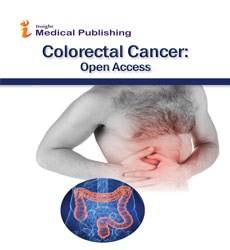Colorectal Tumour Markers CEA and CA19-9 and RAS GTPase proteins Regulation role in Metastatic cancer
Andrew E. Bennett
Andrew E. Bennett*
Department of Surgery, Omiya Medical Center Saitama, Japan
- *Corresponding Author:
- Andrew E. Bennett Department of Surgery, Omiya Medical Center Saitama, Japan, Email: abennet1@bidc.harvard.edu
Received: November 09, 2021; Accepted: November 23, 2021; Published: November 30, 2021
Citation: Andrew E. Bennett (2021) Colorectal Tumour Markers CEA and CA19-9 and RAS GTPase proteins Regulation role in Metastatic cancer Vol.7 No.6:1
Introduction
CEA and CA19-9 are the two most prominent colorectal cancer melanoma markers that are currently used in clinical trials.CEA has a positive rate of 40-60% and CA19-9 has a positive rate of 30-50%.The use of both markers at the same time is beneficial in evaluating the therapeutic effect and monitoring the recurrence of advanced colorectal cancer.Clinical specimens may also be useful in determining the best course of treatment for sick people.
We examined micrometastasis in surgically resected lymph nodes to assess the spread of cancer cells and the malignant potential of colorectal cancer.Immunohistochemical analysis using an anticytokeratin antibody revealed that micrometastasis had no effect on patient prognosis, whereas an RT-PCR assay using CEA as a genetic marker suggested a positive value in predicting a rapid recurrence.We identified several dna tools.
RAS are GTPase proteins that are involved in transcriptional regulation, cell growth, differentiation, proliferation, and survival1,2 and are encoded by genes in the RAS family. KRAS and HRAS were discovered in human cancer cells after being discovered in Kirsten sarcoma3 and the Harvey sarcoma virus4. 5NRAS was discovered in human neuroblastoma cells years later. 6RAS mutations result in defective GTPaseactivity, which causes hyperactivation of the signalling cascade,7resulting in uncontrolled activity of downstream effectors such as RAF protein molecules and MAP-Kinases. RAS mutations are found in approximately 20–25 percent of human cancers8, with incolorectal cancers being the most common (CRC) KRAS mutations are found in approximately 40% of cases and more frequently affect base pair 12 (79%) and codon 13 (17%) percent, 9HRAS mutations are insignificant events, and NRAS genetic variants are found in approximately 3–5% of CRC, most frequently in base pair 61. (60 percent ). 10KRAS mutations have been widely investigated in patients with metastatic CRC (mCRC) in recent years and are now recognised as determinants of resistance to anti-epidermal growth factor receptor (EGFR) monoclonal anti-bodies (MoAbs). 11–18In addition, KRASmutated tumours have been linked to specific clinical characteristics such as the occurrence of lung and brain metastases or right-sided primary tumours. 19–21In terms of clinical outcome, the effect of KRAS mutations, both adjuvant and metastatic, is still debatable, despite being advocated as a mild negative prognostic marker in many studies. 12,22–26 RAF has also been well described as a GTP-ase protein involved in signal transduction, cellular proliferation, and cancerogenesis. 27,28BRAF activating mutations, primarily affecting codon 600, are found in approximately 8% of CRC tumours. 29 The BRAF mutation has a well-known negative prognostic impact in mCRC. 24,30–32, and is linked to a remarkableSome clinicopathologic and diagnostic characteristics include the following: they are more common in the elderly and females, are right-sided, mucinous, microsatellite instable, and have a high rate of nodal and peritoneal metastases.
Finally, several evidences highlighted the ineffectiveness of anti- EGFR MoAbs in BRAF mutated tumours. 36–38 Many targeted strategies for BRAFmutated tumours are being investigated due to the potential role of BRAFmutation as a driver signal in tumour progression 39.
Acknowledgements
The author is thankful to the people who supported and participated in this research. as well as the research and development team for their invaluable support during the study.
Conflict of Interest
There is no conflict disclosed in this article.
Open Access Journals
- Aquaculture & Veterinary Science
- Chemistry & Chemical Sciences
- Clinical Sciences
- Engineering
- General Science
- Genetics & Molecular Biology
- Health Care & Nursing
- Immunology & Microbiology
- Materials Science
- Mathematics & Physics
- Medical Sciences
- Neurology & Psychiatry
- Oncology & Cancer Science
- Pharmaceutical Sciences
